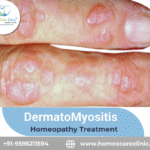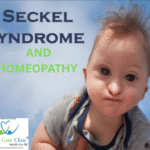Fibrodysplasia ossificans progressiva (FOP):
Fibrodysplasia ossificans progressiva (FOP) is a very rare genetic disorder in which soft tissues like muscles, tendons, and ligaments gradually transformed into bones by the process of ossification. This leads to the formation of extra bone outside the normal skeleton.
This condition leads to the gradual loss of mobility due to locking of joints
Causes of Fibrodysplasia ossificans progressiva (FOP)
- Genetic Mutation:
FOP is primarily caused by a mutation in the ACVR1 gene. This gene responsible for making a protein called a bone morphogenetic protein (BMP) type I receptor.
This mutation results in an overactivity of the receptor, causing the excess production of bone tissue in places where it shouldn’t.
- Autosomal Dominant Inheritance:
FOP is an inherited autosomal dominant disorder. This means that only one copy of the mutated gene is needed to cause the disorder.
Symptoms of Fibrodysplasia ossificans progressiva (FOP)
- Malformation of big toes. These may be short, turned inward, or have other abnormalities.
- Painful swelling and inflammation in muscles, tendons, and ligaments. The inflamed tissue begins to turn into bone (ossify). This process leads to the formation of extra skeletal bone.
- Progressive loss of mobility:
As extra bone forms, joints become restricted, leading to a gradual loss of mobility.
- When ossification affects the jaw and surrounding muscles, it can result in difficulty opening the mouth, leading to problems with eating and speaking.
- Skeletal abnormalities, such as short thumbs.
- Neurological symptoms, such as headaches, and sensory abnormalities.
Life expectancy:
Life expectancy for individuals with FOP may vary but most people live into their 40s or 50s.
The prime causes of early mortality are complications occurred due to breathing difficulties from chest wall restriction and issues such as pneumonia or heart failure. However, with better supportive care, some individuals live longer.
Treatment for Fibrodysplasia Ossificans Progressiva (FOP)
There is no cure for FOP, but treatment focuses on managing symptoms, reducing flare-ups, and slowing disease progression. Below are the current treatment strategies:
1.Medications
- Corticosteroids (Prednisone):
Used after trauma or flare-ups to reduce inflammation.
- NSAIDs & Pain Relievers:
Ibuprofen, acetaminophen, or COX-2 inhibitors help manage pain and inflammation.
2.Physical Therapy:
Gentle movement to prevent stiffness but avoid overstretching or trauma.
3.Injury Prevention:
Avoid falls and trauma by using protective padding, safe home setups, and soft furniture.
4.Nutritional Support:
A balanced diet supports overall health.
5.Psychological Support:
Counseling and support groups help patients and families cope with the disease.
6.Genetic Therapy:
Future treatments may focus on correcting the ACVR1 gene mutation that causes FOP.
Preventive Care for FOP
Prevention of FOP focuses on avoiding triggers that can accelerate the condition. Here are some key strategies:
- Avoiding Trauma & Invasive Procedures:
Minimize injuries: Avoiding minor trauma, like bumps or falls, unnecessary surgeries, biopsies, or injections: These can worsen symptoms.
Use protective gear: Especially for children, to prevent accidental injuries.
- Manage Inflammation:
Anti-inflammatory medications: Some NSAIDs or experimental drugs may slow progression (consult a specialist).
- Genetic & Family Planning :
Genetic counseling: Helps families understand inheritance risks.
Prenatal testing for families with a history of FOP.
- Lifestyle Adaptations :
Avoid overexertion and maintain movement within safe limits.
Adaptive equipment such as mobility aids to reduce the risk of falls.
Soft bedding & supportive seating
Homeopathic Management of FOP:
Fibrodysplasia Ossificans Progressiva (FOP) is a rare genetic disorder where there is no known cure, homeopathy aims to manage symptoms, improve quality of life, and possibly slow disease progression.
Homeopathy focuses on individualized treatment based on symptoms, constitution, and the patient’s overall health. The following remedies may be considered:
- Calcarea Fluorica
- Useful for abnormal bone growth and ossification disorders.
- May help in reducing excessive bone deposits.
- Silicea
- Promotes proper bone metabolism.
- Helps in conditions with excessive calcification.
- Symphytum Officinale
- Known as “bone knit,” useful for fractures and abnormal bone healing.
- May support bone health and prevent excessive ossification.
- Phosphorus
- Used for bone and nerve-related issues.
- Helps with inflammation and soft tissue calcification.
- Hekla Lava
- Beneficial in cases of abnormal bony growth.
- Reduces swelling and pain associated with bone deformities.
FAQ’s
Here are some frequently asked questions (FAQs) about Fibrodysplasia Ossificans Progressiva (FOP):
- What is FOP?
Fibrodysplasia Ossificans Progressiva (FOP) is a rare genetic disorder in which muscle, tendons, and ligaments gradually turn into bone, restricting movement and forming a second skeleton.
- What causes FOP?
FOP is caused by a mutation in the ACVR1 gene, which controls bone growth. This mutation leads to abnormal bone formation in soft tissues
- What triggers FOP flare-ups?
Flare-ups can be spontaneous or triggered by:
- Minor injuries (bumps, falls, injections)
- Viral infections (flu, COVID-19)
- Surgery or biopsies
- Muscle fatigue or strain
- Is there a cure for FOP?
There is currently no cure, but research is ongoing. Treatments aim to manage symptoms and prevent flare-ups.
- Can people with FOP have surgery?
Surgery is generally not recommended because it worsens the excessive bone growth.
In conclusion, Homeo Care Clinic offers a holistic approach to treating the disease. The remedies mentioned above can treat the underlying causes of the condition and offer relief from the discomfort. However, it is important to consult a qualified homeopathic practitioner for the correct dosage and duration of treatment. Homeo Care Clinic provides comprehensive care for various ailments, and offers customized treatment plans based on individual requirements.
To schedule an appointment or learn more about our treatment, please visit our website or give us a call +91 9595211594 our best homeopathy doctor will be here to help.
Follow us on Facebook, Twitter, and Instagram for valuable insights into the world of homeopathy and holistic health.
Facebook – https://www.facebook.com/homeocareclinicpune
Instagram – https://www.instagram.com/homeocareclinic_in
Website – https://www.homeocareclinic.in
Chat with a best homeopathic doctor privately
If you have any queries regarding your disease or any symptoms, click to send a WhatsApp message. Our best homeopathy doctor will be happy to answer you.
Book an Appointment
If you want to visit our clinic, click to book an appointment.
Online treatment
If you are a busy professional, or you are living in a remote town or city, with no best homeopathic doctor near you, Click to start an online homeopathic treatment with the world’s exclusive, most experienced and best homeopathic clinic, managed by Dr. Vaseem Choudhary world-renowned homeopathic doctor expert






